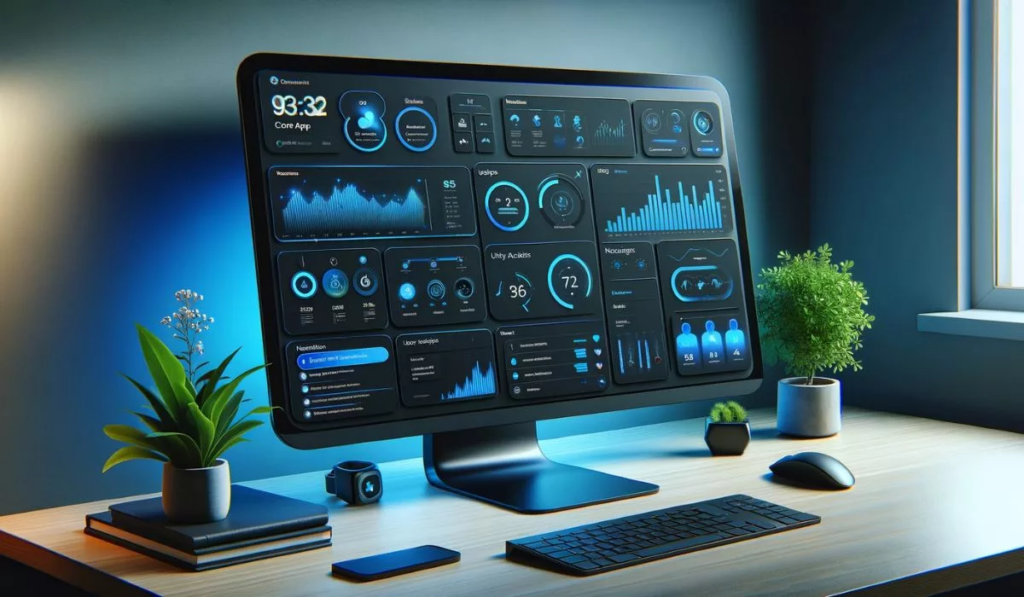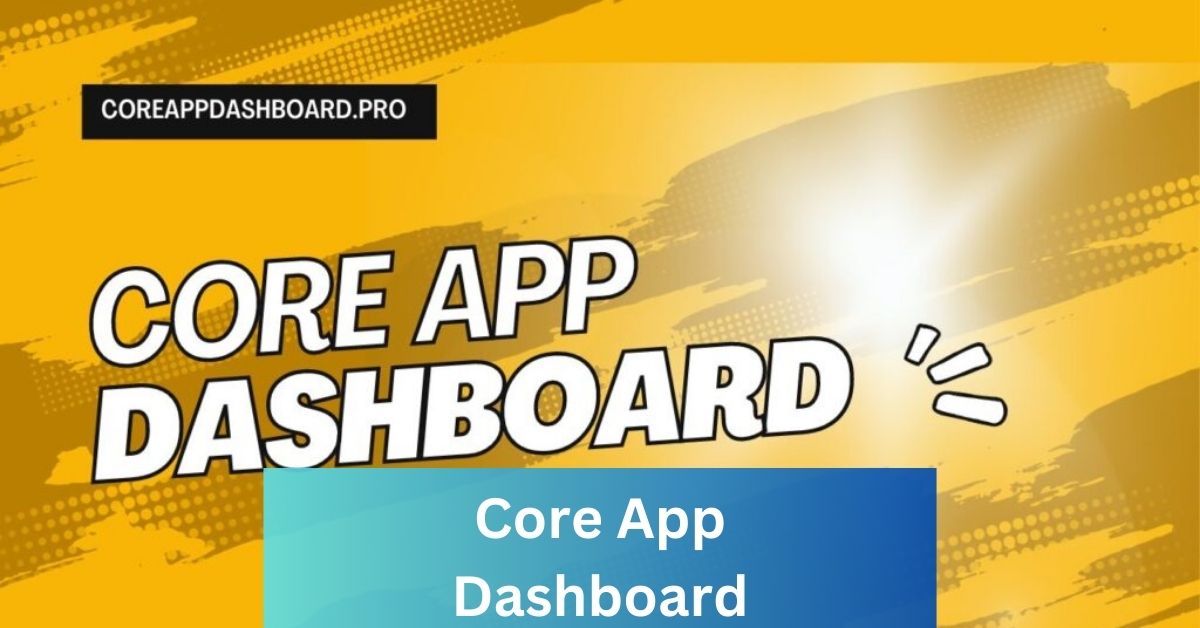In today’s digital landscape, where we juggle multiple apps for nearly every aspect of our lives, navigating and monitoring their performance can be overwhelming.
That’s where the core app dashboard steps in, offering a centralized platform for managing and gaining insights into the apps essential to your workflow.
This article delves into the intricacies of core app dashboards, exploring their functions, benefits, and best practices for optimal implementation.
What Is the Core App Dashboard?
A core app dashboard is a visual interface that aggregates data and functions related to your most critical applications.
It provides a bird’s-eye view of their performance, enabling you to track key metrics, manage user access, and troubleshoot issues, all within a single hub.

Imagine a command center for your most relied-upon tools, where essential information is presented at a glance, boosting your productivity and streamlining app management.
Also Read: What is Jable : Exploring Its Origins and Significance
Key Components of a Core App Dashboard:
- Metrics Visualization: Visualize real-time or historical data through charts, graphs, and tables, revealing insights into user engagement, performance, and resource utilization.
- App Health Monitoring: Track the uptime, responsiveness, and error rates of your crucial apps, proactively identifying potential issues before they impact workflows.
- User Management: Control user access, permissions, and roles for each app, ensuring secure and compliant access to sensitive data.
- Integrations: Seamlessly integrate with other productivity tools like calendars, communication platforms, and reporting systems for a cohesive workflow.
- Customization: Personalize the dashboard layout and information displayed to align with your specific needs and priorities.
How Does It Work?
Core app dashboards often connect to the underlying APIs of your chosen apps, pulling data and presenting it in a digestible format.
Some advanced dashboards may employ machine learning algorithms to analyze trends and predict potential issues, offering proactive alerts and recommendations.
Functionality of a Core App Dashboard:
- Centralized Access: Launch, switch between, and manage all your essential apps from a single platform.
- Performance Monitoring: Monitor app uptime, resource utilization, and user activity to identify inefficiencies and bottlenecks.
- Data Visualization: Gain actionable insights through visually compelling charts and dashboards that highlight key metrics.
- Alerting and Notification: Receive immediate notifications about critical events, app outages, or security threats.
- User Management: Assign access levels, control permissions, and monitor user activity across all integrated apps.
- Trend Analysis: Analyze historical data to predict future usage patterns and optimize app resources.
- Reporting and Exporting: Generate detailed reports on app performance and user activity for further analysis and decision-making.
Benefits of Implementing a Core App Dashboard:
- Increased Productivity: Streamlined app access and centralized management leads to increased efficiency and reduced task switching.
- Improved Visibility: Gaining real-time insights into app performance empowers informed decision-making and proactive problem-solving.
- Enhanced Security: Centralized user management and security monitoring safeguards sensitive data and improves compliance.
- Reduced Costs: Optimizing app resources and identifying unused services can lead to cost savings.
- Improved User Experience: Providing a unified user interface for essential apps simplifies workflows and boosts user satisfaction.
Challenges in Designing Core App Dashboard:
- Integration Complexity: Seamlessly integrating with diverse app APIs can be technically challenging.
- Data Security and Privacy: Ensuring robust data security and user privacy within the dashboard requires careful consideration.
- Customization Demands: Balancing individual user needs with a cohesive dashboard design can be tricky.
- Information Overload: Presenting too much data can overwhelm users and hinder comprehension.

Comparing Core App Dashboard to Alternatives:
- Individual App Interfaces: Switching between multiple app interfaces can be time-consuming and inefficient.
- Standalone Monitoring Tools: Fragmented monitoring tools lack the comprehensiveness and centralized view offered by core app dashboards.
- Custom-Built Solutions: Development costs and resource demands of custom solutions can be significant.
Also Read: Vaçpr: Revolutionizing Skincare & Well–Being In 2023
Best Practices for Creating an Effective Core App Dashboard:
- Identify Your Core Apps: Focus on integrating the apps you rely on most heavily.
- Prioritize Key Metrics: Displaying too much data can be overwhelming. Focus on metrics that directly impact your goals.
- Visual Clarity: Design clear and intuitive visualizations for easy understanding.
- Customization: Allow users to personalize the dashboard layout and information displayed.
- Mobile Accessibility: Ensure accessibility for mobile users with optimized layouts and functionalities.

Tips for Choosing a Core App Dashboard Solution:
- Integration Capabilities: Choose a solution compatible with your most essential apps.
- Customization Options: Ensure the platform offers sufficient customization to suit your specific needs.
- Security and Privacy: Prioritize solutions with robust security measures and user privacy protections.
Emerging Technologies:
The future of core app dashboards is bright, fueled by innovative technologies like:
- Artificial Intelligence (AI): AI-powered dashboards will offer predictive analytics, automated anomaly detection, and personalized recommendations for app optimization.
- Natural Language Processing (NLP): Conversational interfaces and voice commands will enable hands-free interaction with the dashboard, further streamlining workflows.
- Biometric Authentication: Seamless integration with biometric data will enhance security and simplify user access.
Adapting to Change:
As app ecosystems evolve, core app dashboards will need to keep pace:
- Dynamic Integrations: Continuous app integration updates will ensure compatibility with the latest tools and services.
- Security Enhancements: Evolving security threats necessitate proactive measures like real-time threat detection and mitigation protocols.
- Data Privacy Focus: Increasingly stringent data privacy regulations will require dashboards to prioritize user control and transparency.
Also Read: Misty Severi: Unveiling the Persona Behind the Name
Conclusion:
Core app dashboards are poised to become the nerve centers of our digital lives, providing a centralized hub for managing crucial apps, optimizing workflows, and gaining actionable insights.
By embracing emerging technologies, adapting to change, and prioritizing user needs, core app dashboards will unlock new levels of productivity and empower us to navigate the ever-evolving digital landscape with confidence.
FAQ’s:
Q1: What apps can I connect to a core app dashboard?
Most popular apps offer API integration, allowing connection to your dashboard. Check your individual app’s documentation for compatibility.
Q2: Will using a dashboard slow down my apps?
Efficient dashboards use minimal resources. However, if you integrate heavy-duty apps, monitor performance and adjust integrations if needed.
Q3: Can I share my dashboard with others?
Some platforms offer controlled sharing permissions, letting you grant access to specific individuals or teams while maintaining data security.
Q4: How much does a core app dashboard cost?
Costs vary depending on features and integrations. Free options exist for basic use, while advanced solutions with extensive customization may require subscriptions.
Q5: Can I build my own custom core app dashboard?
While technically possible, it requires significant technical expertise and ongoing maintenance. Consider user-friendly pre-built options for faster implementation and ease of use.
Q6: How secure is my data within a core app dashboard?
Choose solutions with robust security measures like data encryption, user authentication, and access control to ensure your data’s safety.
Q7: How will core app dashboards evolve in the future?
Expect AI-powered insights, voice control interfaces, and even deeper integration with emerging technologies like wearables and smart devices.
